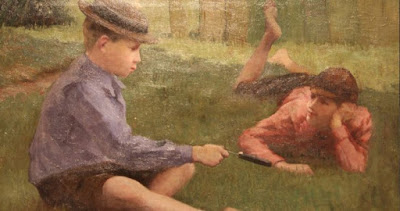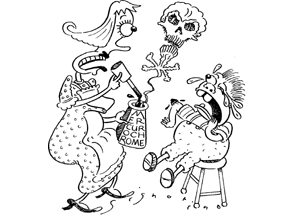Chris Wallace: You have repeatedly criticized the vice president for not specifically calling out antifa and other left-wing extremist groups. But are you willing, tonight, to condemn white supremacists and militia groups and to say that they need to stand down and not add to the violence in a number of these cities as we saw in Kenosha and as we've seen in Portland? Are you prepared to specifically do that?
Donald Trump: Sure, I'm prepared to do that. But I would say almost everything I see is from the left wing, not from the right wing. If you look, I'm willing to do anything. I want to see peace.
Wallace: Then do it, sir.
Biden: Do it. Say it.
Trump: You want to call them? What do you want to call them? Give me a name, give me a name, go ahead — who would you like me to condemn?
Wallace: White supremacists, white supremacists and right-wing militia.
Trump: Proud Boys, stand back and stand by. But I'll tell you what: Somebody's got to do something about antifa and the left. Because this is not a right-wing problem – this is a left-wing problem.”
– Presidential Debate, September 29, 2020
Trump's hesitation, once again, to denounce white supremacy during Tuesday's presidential debate is mind blowing. During an exchange on the debate stage, moderator Chris Wallace repeatedly asked Trump if he would condemn white supremacists. Trump repeatedly didn't answer the question, and contended, with no citation, that the violence came from left-wing groups, but Wallace kept pressing.
Trump eventually responded to Wallace's question by referring to a white supremacist group, saying, "Proud Boys, stand back and stand by. But I'll tell you what: Somebody's got to do something about antifa and the left. Because this is not a right-wing problem – this is a left-wing problem.
Trump has in the past sought to blame violence stemming from some recent protests on antifa, an umbrella term for radical left-wing activist groups that sometimes engage in street brawls.
"Within the racially motivated violent extremist bucket, people subscribing to some kind of white supremacist ideology is certainly the biggest chunk."
– FBI Director Christopher Wray
Contrary to the narrative promoted by Trump, experts who study domestic extremism as well as FBI Director Christopher Wray and acting Homeland Security Secretary Chad Wolf have both testified to Congress that white supremacist violence is the most persistent and deadly domestic terror threat facing the country.
Biden pointed out Wray’s comments during the debate, to which Trump said, “Well, you know what? He’s wrong.”
“The facts are right now that right-wing extremism is the bigger problem (not the radicals of antifa.) That’s where the violence is coming from.
– Heidi Beirich, co-founder of the Global Project Against Hate and Extremism and former director of the Southern Poverty Law Center’s Intelligence Project, where she spent the past two decades tracking and reporting on far-right extremist activity in the U.S.
The Proud Boys quickly embraced the moment on Telegram, an encrypted messaging service popular among extremist groups, posting clips of the president’s comment and even circulating an image with Trump’s quote superimposed over their logo.
Who Are the Proud Boys?
According to the Southern Poverty Law Center, the Proud Boys were established in the midst of the 2016 presidential election by VICE Media co-founder Gavin McInnes. They are self-described “western chauvinists” who adamantly deny any connection to the racist “alt-right,” insisting they are simply a fraternal group spreading an “anti-political correctness” and “anti-white guilt” agenda. In truth, the Proud Boys is a far-right, anti-immigrant, all-male group with a history of street violence against its left-wing opponents.
Their disavowals of bigotry are belied by their actions: rank-and-file Proud Boys and leaders regularly spout white nationalist memes and maintain affiliations with known extremists. They are known for anti-Muslim and misogynistic rhetoric. Proud Boys have appeared alongside other hate groups at extremist gatherings like the "Unite the Right" rally in Charlottesville. Former Proud Boys member Jason Kessler helped to organize the event, which brought together Klansmen, antisemites, Southern racists, and militias. Kessler was only “expelled” from the group after the violence and near-universal condemnation of the Charlottesville rally-goers.
"I have been tried for attempted murder and multiple batteries and hate crimes. My JTTF [Joint Terrorism Task Force] file is a mile long."
– Brien James
The turn toward violence — and the blurring borders between ‘alt-lite’ and ‘alt-right’ — is typified by Brien James, the state representative for the Indiana Proud Boys and a member of FOAK (Fraternal Order of Alt-Knights. James gained his racist skinhead credentials in the Outlaw Hammerskins and the Hoosier State Skinheads before becoming one of the founding members of the Vinlanders Social Club (VSC), a racist gang known for its extreme violence. Since its creation in 2003, the VSC has been linked to at least nine murders nationwide. James once bragged that his Joint Terrorism Task Force file was “a mile long,” and allegedly nearly beat a man to death for refusing to Seig Heil at a party.
Is Trump's refusal to denounce white supremacists reflective of his own preferred racist views?
The Brookings Research Instititute reported (2019) …
“Donald Trump’s support in the 2016 campaign was clearly driven by racism, sexism, and xenophobia. While some observers have explained Trump’s success as a result of economic anxiety, the data demonstrate that anti-immigrant sentiment, racism, and sexism are much more strongly related to support for Trump …
“Even more alarmingly, there is a clear correlation between Trump campaign events and incidents of prejudiced violence. FBI data show that since Trump’s election there has been an anomalous spike in hate crimes concentrated in counties where Trump won by larger margins. It was the second-largest uptick in hate crimes in the 25 years for which data are available, second only to the spike after September 11, 2001.
“The association between Trump and hate crimes is not limited to the election itself. Another study, based on data collected by the Anti-Defamation League, shows that counties that hosted a Trump campaign rally in 2016 saw hate crime rates more than double compared to similar counties that did not host a rally …
'There is also causal evidence to point to. In experiments, being exposed to Trump’s rhetoric actually increases expressions of prejudice. (2017 survey – “Follow the Racist? The Consequences of Trump’s Expressions of Prejudice for Mass Rhetoric” by Brian F. Schaffner et al.)
(Vanessa Williamson and Isabella Gelfand. “Trump and racism: What do the data say?” Brookings. August 14, 2019.)
Donald Trump is a racist. Like most other cloaked racists of 2020, he deflects his views and refuses to acknowledge the bigotry of his White Nationalistic agenda. Several studies and surveys have shown that racist attitudes and racial resentment have fueled Trump's political ascendance, and have become more significant than economic factors in determining the party allegiance of U.S. voters. This makes Trump a racist of the worst kind. He uses hatred and bigotry for his own personal and political advantage. Trump employs blatant racism and xenophobia to excite his base and to strengthen his support among the White working class.
“For the past 40 years, the right wing has peddled a winning strategy to keep Americans divided: sell the economic agenda of the 1% to working- and middle-class white voters through a hidden formula: Fear People of Color --> Hate Government --> Trust the Market and the 1%.”
– Heather McGhee, president of Demos, a progressive think tank and MoveOn ally
UC Berkeley Professor Ian Haney López teamed up with MoveOn.org Civic Action, Demos Action, and Inequality Media, to demonstrate how Republican presidential candidate Donald Trump relies on racism as a strategy to divide the country for the benefit of himself and other wealthy Americans. He uses racism by triggering two major sources of anxiety for many white people: economic insecurity and demographic change.
Trump's approach isn't new in American politics. It’s part of a legacy of racism going back to the country’s founding, when the authors of the Constitution gave slaveholders immense political power while allowing them to treat enslaved Africans as less than human.“ It taps into this racial resentment toward Black people that is deep-seated,” said Pearl Dowe, a professor of political science and African American studies at Emory University in Atlanta. Dowe continued: “Politicians use it because it works. When Donald Trump talks about ‘heritage,’ he means who has the heritage to be an American citizen.”
“He’s deliberately pandered to the idea that America is a nation rooted in white culture and power,” Dowe said. “Others that reside here just reside; they are not due the full rights of citizenship. If others – people of color – stake their rights to citizenship and equality, then the way of life that white people are comfortable with will be no more.”
Tyrone Beason of the Los Anglese Times explains. “Trump demonizes entire ethnic groups as not fully American, lashes out at protesters and insinuates that white people, not people of color, are the ones most in need of protection.”
Jonathan Allen, a senior political analyst for NBC News, says Donald Trump has positioned himself as “the defender-in-chief not only of the Founding Fathers but of Confederates who actually tried to dissolve the Union and made war on it.”
God damn Trump for his racism. When Trump repeatedly accuses a reporter of “racism” for questioning him about his embrace of the term “nationalist,” he is deliberately drawing from the toxic well of white supremacist discourse and directly addressing that base.
“We have been insufficiently attentive to how carefully crafted and targeted Trump’s new right discourse and politics are, how they deliberately encourage and mobilize extremists, and normalize them as a crucial political constituency. President Trump is enabling extremists through what sociologists refer to as 'scripted violence.'
“We tend to say that Trump is 'dog-whistling' to white nationalists and supremacists; but it is far more serious than that. Speaking openly to the new right, Trump is rallying and emboldening a counterrevolutionary politics. If the American people do not act soon, we risk being caught in a downward authoritarian spiral or violent civil strife.”
– Bernard E. Harcourt is a professor of law and political science at Columbia University and the author of The Counterrevolution: How Our Government Went to War Against Its Own Citizens (2018)

















